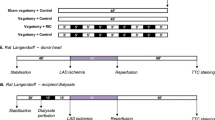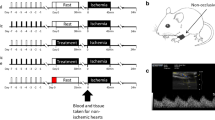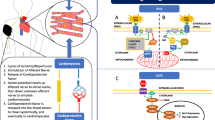Abstract
Remote ischemic preconditioning (rIPC) induced by transient limb ischemia (li-rIPC) leads to neurally dependent release of blood-borne factors that provide potent cardioprotection. We hypothesized that transcutaneous electrical nerve stimulation (TENS) is a clinically relevant stimulus of rIPC. Study 1: seven rabbits were subjected to lower limb TENS; six to li-rIPC, and six to sham intervention. Blood was drawn and used to prepare a dialysate for subsequent analysis of cardioprotection in rabbit Langendorff preparation. Study 2: 14 healthy adults underwent upper limb TENS stimulation on one study day, 10 of whom also underwent li-rIPC on another study day. Blood was drawn before and after each stimulus, dialysate prepared, and cardioprotective activity assessed in mouse Langendorff preparation. The infarct size and myocardial recovery were measured after 30 min of global ischemia and 60 or 120 min of reperfusion. Animal validation: compared to control, TENS induced marked cardioprotection with significantly reduced infarct size (TENS vs. sham p < 0.01, rIPC vs. sham p < 0.01, TENS vs. rIPC p = ns) and improved functional recovery during reperfusion. Human study: compared to baseline, dialysate after rIPC (pre-rIPC vs. post-rIPC, p < 0.001) and TENS provided potent cardioprotection (pre-TENS vs. post-TENS p < 0.001) and improved myocardial recovery during reperfusion. The cardioprotective effects of TENS dialysates were blocked by pretreatment of the receptor heart with the opioid antagonist naloxone. TENS is a novel method for inducing cardioprotection and may provide an alternative to the limb ischemia stimulus for induction of rIPC clinically.





Similar content being viewed by others
References
Birnbaum Y, Hale SL, Kloner RA (1997) Ischemic preconditioning at a distance: reduction of myocardial infarct size by partial reduction of blood supply combined with rapid stimulation of the gastrocnemius muscle in the rabbit. Circulation 96:1641–1646. doi:10.1161/01.CIR.96.5.1641
Boengler K, Buechert A, Heinen Y, Roeskes C, Hilfiker-Kleiner D, Heusch G, Schulz R (2008) Cardioprotection by ischemic postconditioning is lost in aged and STAT3-deficient mice. Circ Res 102:131–135. doi:10.1161/CIRCRESAHA.107.164699
Botker HE, Kharbanda R, Schmidt MR, Bottcher M, Kaltoft AK, Terkelsen CJ, Munk K, Andersen NH, Hansen TM, Trautner S, Lassen JF, Christiansen EH, Krusell LR, Kristensen SD, Thuesen L, Nielsen SS, Rehling M, Sorensen HT, Redington AN, Nielsen TT (2010) Remote ischaemic conditioning before hospital admission, as a complement to angioplasty, and effect on myocardial salvage in patients with acute myocardial infarction: a randomised trial. Lancet 375:727–734. doi:10.1016/S0140-6736(09)62001-8
Celander O, Folkow B (1953) The nature and the distribution of afferent fibres provided with the axon reflex arrangement. Acta Physiol Scand 29:359–370. doi:10.1111/j.1748-1716.1953.tb01031.x
Cheung MM, Kharbanda RK, Konstantinov IE, Shimizu M, Frndova H, Li J, Holtby HM, Cox PN, Smallhorn JF, Van Arsdell GS, Redington AN (2006) Randomized controlled trial of the effects of remote ischemic preconditioning on children undergoing cardiac surgery: first clinical application in humans. J Am Coll Cardiol 47:2277–2282. doi:10.1016/j.jacc.2006.01.066
Conti A, Scala S, D’Agostino P, Alimenti E, Morelli D, Andria B, Tammaro A, Attanasio C, Della Ragione F, Scuderi V, Fabbrini F, D’Esposito M, Di Florio E, Nitsch L, Calise F, Faiella A (2007) Wide gene expression profiling of ischemia–reperfusion injury in human liver transplantation. Liver Transplant 13:99–113. doi:10.1002/lt.20960
Dickson EW, Blehar DJ, Carraway RE, Heard SO, Steinberg G, Przyklenk K (2001) Naloxone blocks transferred preconditioning in isolated rabbit hearts. J Mol Cell Cardiol 33:1751–1756. doi:10.1006/jmcc.2001.1436
Dickson EW, Lorbar M, Porcaro WA, Fenton RA, Reinhardt CP, Gysembergh A, Przyklenk K (1999) Rabbit heart can be “preconditioned” via transfer of coronary effluent. Am J Physiol 277:H2451–H2457
Ding YF, Zhang MM, He RR (2001) Role of renal nerve in cardioprotection provided by renal ischemic preconditioning in anesthetized rabbits. Sheng Li Xue Bao 53:7–12
Dong JH, Liu YX, Ji ES, He RR (2004) Limb ischemic preconditioning reduces infarct size following myocardial ischemia–reperfusion in rats. Sheng Li Xue Bao 56:41–46
Dong JH, Liu YX, Zhao J, Ma HJ, Guo SM, He RR (2004) High-frequency electrical stimulation of femoral nerve reduces infarct size following myocardial ischemia–reperfusion in rats. Sheng Li Xue Bao 56:620–624
Evans MS, Reid KH, Sharp JB Jr (1993) Dimethylsulfoxide (DMSO) blocks conduction in peripheral nerve C fibers: a possible mechanism of analgesia. Neurosci Lett 150:145–148. doi:10.1016/0304-3940(93)90522-m
Gho BC, Schoemaker RG, van den Doel MA, Duncker DJ, Verdouw PD (1996) Myocardial protection by brief ischemia in noncardiac tissue. Circulation 94:2193–2200. doi:10.1161/01.CIR.94.9.2193
Han JS, Chen XH, Sun SL, Xu XJ, Yuan Y, Yan SC, Hao JX, Terenius L (1991) Effect of low- and high-frequency TENS on Met-enkephalin-Arg-Phe and dynorphin A immunoreactivity in human lumbar CSF. Pain 47:295–298
Heusch G, Musiolik J, Kottenberg E, Peters J, Jakob H, Thielmann M (2012) STAT5 activation and cardioprotection by remote ischemic preconditioning in humans: short communication. Circ Res 110:111–115. doi:10.1161/CIRCRESAHA.111.259556
Huda R, Chung DH, Mathru M (2005) Ischemic preconditioning at a distance: altered gene expression in mouse heart and other organs following brief occlusion of the mesenteric artery. Heart Lung Circ 14:36–43. doi:10.1016/j.hlc.2004.11.006
Jensen RV, Stottrup NB, Kristiansen SB, Botker HE (2012) Release of a humoral circulating cardioprotective factor by remote ischemic preconditioning is dependent on preserved neural pathways in diabetic patients. Basic Res Cardiol 107:285. doi:10.1007/s00395-012-0285-1
Jones WK, Fan GC, Liao S, Zhang JM, Wang Y, Weintraub NL, Kranias EG, Schultz JE, Lorenz J, Ren X (2009) Peripheral nociception associated with surgical incision elicits remote nonischemic cardioprotection via neurogenic activation of protein kinase C signaling. Circulation 120:S1–S9. doi:10.1161/CIRCULATIONAHA.108.843938
Kharbanda RK, Mortensen UM, White PA, Kristiansen SB, Schmidt MR, Hoschtitzky JA, Vogel M, Sorensen K, Redington AN, MacAllister R (2002) Transient limb ischemia induces remote ischemic preconditioning in vivo. Circulation 106:2881–2883. doi:10.1161/01.CIR.0000043806.51912.9B
Kharbanda RK, Nielsen TT, Redington AN (2009) Translation of remote ischaemic preconditioning into clinical practice. Lancet 374:1557–1565. doi:10.1016/S0140-6736(09)61421-5
Konstantinov IE, Arab S, Kharbanda RK, Li J, Cheung MM, Cherepanov V, Downey GP, Liu PP, Cukerman E, Coles JG, Redington AN (2004) The remote ischemic preconditioning stimulus modifies inflammatory gene expression in humans. Physiol Genomics 19:143–150. doi:10.1152/physiolgenomics.0 0046.2004
Konstantinov IE, Li J, Cheung MM, Shimizu M, Stokoe J, Kharbanda RK, Redington AN (2005) Remote ischemic preconditioning of the recipient reduces myocardial ischemia–reperfusion injury of the denervated donor heart via a Katp channel-dependent mechanism. Transplantation 79:1691–1695
Kottenberg E, Musiolik J, Thielmann M, Jakob H, Peters J, Heusch G (2014) Interference of propofol with signal transducer and activator of transcription 5 activation and cardioprotection by remote ischemic preconditioning during coronary artery bypass grafting. J Thorac Cardiovasc Surg 147(1):376–382. doi: 10.1016/j.jtcvs.2013.01.005
Kottenberg E, Thielmann M, Bergmann L, Heine T, Jakob H, Heusch G, Peters J (2012) Protection by remote ischemic preconditioning during coronary artery bypass graft surgery with isoflurane but not propofol—a clinical trial. Acta Anaesthesiol Scand 56:30–38. doi:10.1111/j.1399-6576.2011.02585.x
Liem DA, Verdouw PD, Ploeg H, Kazim S, Duncker DJ (2002) Sites of action of adenosine in interorgan preconditioning of the heart. Am J Physiol Heart Circ Physiol 283:H29–H37. doi:10.1152/ajpheart.0 1031.2001
Linden MD, Whittaker P, Frelinger AL 3rd, Barnard MR, Michelson AD, Przyklenk K (2006) Preconditioning ischemia attenuates molecular indices of platelet activation-aggregation. J Thromb Haemost 4:2670–2677. doi:10.1111/j.1538-7836.2006.02228.x
Loukogeorgakis SP, Panagiotidou AT, Broadhead MW, Donald A, Deanfield JE, MacAllister RJ (2005) Remote ischemic preconditioning provides early and late protection against endothelial ischemia–reperfusion injury in humans: role of the autonomic nervous system. J Am Coll Cardiol 46:450–456. doi:10.1016/j.jacc.2005.04.044
Lu Y, Zhou J, Xu C, Lin H, Xiao J, Wang Z, Yang B (2008) JAK/STAT and PI3 K/AKT pathways form a mutual transactivation loop and afford resistance to oxidative stress-induced apoptosis in cardiomyocytes. Cell Physiol Biochem 21:305–314. doi:10.1159/000129389
Michelsen MM, Stottrup NB, Schmidt MR, Lofgren B, Jensen RV, Tropak M, St-Michel EJ, Redington AN, Botker HE (2012) Exercise-induced cardioprotection is mediated by a bloodborne, transferable factor. Basic Res Cardiol 107:260. doi:10.1007/s00395-012-0260-x
Murry CE, Jennings RB, Reimer KA (1986) Preconditioning with ischemia: a delay of lethal cell injury in ischemic myocardium. Circulation 74:1124–1136. doi:10.1161/01.CIR.74.5.1124
Peart JN, Gross GJ (2006) Cardioprotective effects of acute and chronic opioid treatment are mediated via different signaling pathways. Am J Physiol Heart Circ Physiol 291:H1746–H1753. doi:10.1152/ajpheart.0 0233.2006
Pell TJ, Baxter GF, Yellon DM, Drew GM (1998) Renal ischemia preconditions myocardium: role of adenosine receptors and ATP-sensitive potassium channels. Am J Physiol 275:H1542–H1547
Przyklenk K, Bauer B, Ovize M, Kloner RA, Whittaker P (1993) Regional ischemic ‘preconditioning’ protects remote virgin myocardium from subsequent sustained coronary occlusion. Circulation 87:893–899. doi:10.1161/01.CIR.87.3.893
Raza A, Dikdan G, Desai KK, Shareef A, Fernandes H, Aris V, de la Torre AN, Wilson D, Fisher A, Soteropoulos P, Koneru B (2010) Global gene expression profiles of ischemic preconditioning in deceased donor liver transplantation. Liver Transplant 16:588–599. doi:10.1002/lt.22049
Redington KL, Disenhouse T, Strantzas SC, Gladstone R, Wei C, Tropak MB, Dai X, Manlhiot C, Li J, Redington AN (2012) Remote cardioprotection by direct peripheral nerve stimulation and topical capsaicin is mediated by circulating humoral factors. Basic Res Cardiol 107:241. doi:10.1007/s00395-011-0241-5
Saade NE, Massaad CA, Ochoa-Chaar CI, Jabbur SJ, Safieh-Garabedian B, Atweh SF (2002) Upregulation of proinflammatory cytokines and nerve growth factor by intraplantar injection of capsaicin in rats. J Physiol 545:241–253. doi:10.1113/jphysiol.2002.028233
Saxena P, Shaw OM, Misso NL, Naran A, Shehatha J, Newman MA, d’Udekem Y, Thompson PJ, Konstantinov IE (2011) Remote ischemic preconditioning stimulus decreases the expression of kinin receptors in human neutrophils. J Surg Res 171:311–316. doi:10.1016/j.jss.2009.11.011
Schoemaker RG, van Heijningen CL (2000) Bradykinin mediates cardiac preconditioning at a distance. Am J Physiol Heart Circ Physiol 278:H1571–H1576
Serejo FC, Rodrigues LF Jr, da Silva Tavares KC, de Carvalho AC, Nascimento JH (2007) Cardioprotective properties of humoral factors released from rat hearts subject to ischemic preconditioning. J Cardiovasc Pharmacol 49:214–220. doi:10.1097/FJC.0b013e3180325ad9
Sergeev P, da Silva R, Lucchinetti E, Zaugg K, Pasch T, Schaub MC, Zaugg M (2004) Trigger-dependent gene expression profiles in cardiac preconditioning: evidence for distinct genetic programs in ischemic and anesthetic preconditioning. Anesthesiology 100:474–488
Shimizu M, Saxena P, Konstantinov IE, Cherepanov V, Cheung MM, Wearden P, Zhangdong H, Schmidt M, Downey GP, Redington AN (2010) Remote ischemic preconditioning decreases adhesion and selectively modifies functional responses of human neutrophils. J Surg Res 158:155–161. doi:10.1016/j.jss.2008.08.010
Shimizu M, Tropak M, Diaz RJ, Suto F, Surendra H, Kuzmin E, Li J, Gross G, Wilson GJ, Callahan J, Redington AN (2009) Transient limb ischaemia remotely preconditions through a humoral mechanism acting directly on the myocardium: evidence suggesting cross-species protection. Clin Sci (Lond) 117:191–200. doi:10.1042/CS20080523
Sjolund BH (1988) Peripheral nerve stimulation suppression of C-fiber-evoked flexion reflex in rats. Part 2: parameters of low-rate train stimulation of skin and muscle afferent nerves. J Neurosurg 68:279–283
Soond SM, Townsend PA, Barry SP, Knight RA, Latchman DS, Stephanou A (2008) ERK and the F-box protein betaTRCP target STAT1 for degradation. J Biol Chem 283:16077–16083. doi:10.1074/jbc.M800384200
Steensrud T, Li J, Dai X, Manlhiot C, Kharbanda RK, Tropak M, Redington A (2010) Pretreatment with the nitric oxide donor SNAP or nerve transection blocks humoral preconditioning by remote limb ischemia or intra-arterial adenosine. Am J Physiol Heart Circ Physiol 299:H1598–H1603. doi:10.1152/ajpheart.0 0396.2010
Steinbeck JA, Methner A (2005) Translational downregulation of the noncatalytic growth factor receptor TrkB.T1 by ischemic preconditioning of primary neurons. Gene Expr 12:99–106
Stenzel-Poore MP, Stevens SL, Xiong Z, Lessov NS, Harrington CA, Mori M, Meller R, Rosenzweig HL, Tobar E, Shaw TE, Chu X, Simon RP (2003) Effect of ischaemic preconditioning on genomic response to cerebral ischaemia: similarity to neuroprotective strategies in hibernation and hypoxia-tolerant states. Lancet 362:1028–1037. doi:10.1016/S0140-6736(03)14412-1
Stephanou A, Scarabelli TM, Brar BK, Nakanishi Y, Matsumura M, Knight RA, Latchman DS (2001) Induction of apoptosis and Fas receptor/Fas ligand expression by ischemia/reperfusion in cardiac myocytes requires serine 727 of the STAT-1 transcription factor but not tyrosine 701. J Biol Chem 276:28340–28347. doi:10.1074/jbc.M101177200
Takaoka A, Nakae I, Mitsunami K, Yabe T, Morikawa S, Inubushi T, Kinoshita M (1999) Renal ischemia/reperfusion remotely improves myocardial energy metabolism during myocardial ischemia via adenosine receptors in rabbits: effects of “remote preconditioning”. J Am Coll Cardiol 33:556–564. doi:10.1016/S0735-1097(98)00559-2
Thielmann M, Kottenberg E, Boengler K, Raffelsieper C, Neuhaeuser M, Peters J, Jakob H, Heusch G (2010) Remote ischemic preconditioning reduces myocardial injury after coronary artery bypass surgery with crystalloid cardioplegic arrest. Basic Res Cardiol 105:657–664. doi:10.1007/s00395-010-0104-5
Weinbrenner C, Nelles M, Herzog N, Sarvary L, Strasser RH (2002) Remote preconditioning by infrarenal occlusion of the aorta protects the heart from infarction: a newly identified non-neuronal but PKC-dependent pathway. Cardiovasc Res 55:590–601. doi:10.1016/S0008-6363(02)00446-7
Wolfrum S, Schneider K, Heidbreder M, Nienstedt J, Dominiak P, Dendorfer A (2002) Remote preconditioning protects the heart by activating myocardial PKCepsilon-isoform. Cardiovasc Res 55:583–589. doi:10.1016/S0008-6363(02)00408-X
Xuan YT, Tang XL, Banerjee S, Takano H, Li RC, Han H, Qiu Y, Li JJ, Bolli R (1999) Nuclear factor-kappaB plays an essential role in the late phase of ischemic preconditioning in conscious rabbits. Circ Res 84:1095–1109. doi:10.1161/01.RES.84.9.1095
Acknowledgments
This study was supported by grants from the Leducq Foundation and Canadian Institutes of Health Research.
Conflicts of interest
ANR has submitted a patent application regarding the use of TENS as a preconditioning stimulus.
Author information
Authors and Affiliations
Corresponding author
Additional information
K. L. Redington is joint first author.
Rights and permissions
About this article
Cite this article
Merlocco, A.C., Redington, K.L., Disenhouse, T. et al. Transcutaneous electrical nerve stimulation as a novel method of remote preconditioning: in vitro validation in an animal model and first human observations. Basic Res Cardiol 109, 406 (2014). https://doi.org/10.1007/s00395-014-0406-0
Received:
Revised:
Accepted:
Published:
DOI: https://doi.org/10.1007/s00395-014-0406-0




